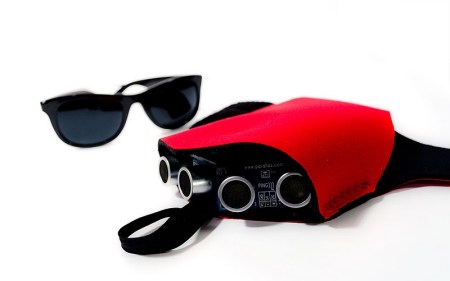Here is a hack that takes the stick out of the blind mans hand. [Steve] has been working on the Tacit, a wrist mounted sonar device with haptic feedback, it’s like strapping a bat to your wrist to help you see. The Tacit uses two sonar ping sensors to measure the distance to the nearest obstacle, the relative distance to an object is then fed back to the user using two servos which apply pressure to the back of the wrist. The Tacit is sporting an Arduino pro mini to control the ping sensors and drive the servos, and runs off a 9 volt battery.
This is not an entirely new concept, haptic headbands have been around on the net for a while, but the Tacit allows the user to detect obstacles on the ground waiting to trip you up. All in all a neat hack that may have a future in helping the blind. Check out the video after the break to see it in action.
[vimeo http://vimeo.com/27675622 w=470]

















Using haptic feedback through pressure is a neat change!
If anyone is more interested in this stuff, here’s an interesting book:
http://books.google.com/books?id=zMxncsODHNIC&pg=PA240&lpg=PA240&dq=mowat+sensor&source=bl&ots=sj9twa37x6&sig=qsmhMpfIoKysF7huWgYwgikNlZ4&hl=en&ei=fqCsTKGYAY6gsQOs6YTEAw&sa=X&oi=book_result&ct=result&resnum=14&ved=0CEYQ6AEwDQ#v=onepage&q=mowat%20sensor&f=false
I’m currently in the process of building a very similar device in a smaller form factor using a maxbotics lv-ez3, a tiny vibration motor and, probably an MSP430 microcontroller. Should take around 100ma at 3.3 volts, which is nice. I might even be able to fit it into a large ring form-factor.
Tacit looks really nice, though.
This is a great idea and not expensive to implement (relatively speaking). My hat goes off to the person/people behind it. In the future I wouldn’t be surprised to see more of these type of devices than traditional white canes.
This is a great concept. Executed nicely. Are these planned for sale? If so, what price range?
What is asstance? xD
As someone who is going blind, i think this is super cool!
How does this work with every day interference? I seem to remember my Quadcopter thinking it was suddenly hundres of feet in the air when it neared refrigerators
This is great and all…but doesn’t the red tipped stick serve a purpose other than feeling around? A red tipped stick will stop traffic, and that a red fanny pack will not.
Good
Awesome. For a totally blind person this may not be the best as they do use the stick to help them feel ahead. They can tell if they are about to hit stairs, grass, a door, etc.
But, for the legally blind, those with extremely poor eyesight, but can still identify shapes but lack any real depth perception, this device is awesome.
Very cool!
I wonder, if over time the areas on the back of the hand receiving feedback would become less sensitive from over use? Maybe the ultrasonic and feedback elements could be separated so each could be placed where the user would like?
The hand is used for many haptic devices because nerve density allows greater sensitivity. I’m not sure about constant stimulation eroding sensitivity: if the haptic compass devices don’t do it, this is unlikely to.
This is the reason I went with pressure rather than super common vibration motors. Exposing the various sensing nerves to vibration gives a bit more precise sensation since it activates three different kinds of nerve cells (Pacinian cells sense the onset of pressure, Merkel cells sense ongoing pressure, and and Messiner’s cells sense the release of pressure). However they go num pretty quickly when exposed to constant vibration. In fact, over the long term it can cause nerve dammage.
I’ll admit I haven’t done long-term trials, but it has been worn for days without any noticeable effect. (Whereas the vibration motors drove me nuts within minutes.) If it’s a concern I would suggest alternating hands every day since it was designed to be right/left switchable. Separating the tactile elements from the sensors would certainly be possible but would make the device much more complex to use for the vision impaired.
I love this kind of stuff. But I would have gone with maybe a time signal or something. perhaps a short (two) electric pulse.
The idea (and this should hold true for just about anything) is the brain can reroute itself. So once it becomes learned, it’s second nature, like eye sight. (I know I’m not describing it well).
And probably use more sensors, like one for high and one for low objects.